Risk Treatment for Energy-Oriented Production Plans through the Selection, Classification, and Integration of Suitable Measures
Abstract
:1. Introduction
2. State of the Art
2.1. Risk Management and Energy-Oriented PPC
2.2. Solving Complex Decision Problems
2.3. Categorization of Measures
2.4. Need for Research
- Energy-oriented PPC mostly neglects operational fault and risk management or is based on complex algorithms with little practical suitability. In order to implement the selected measures, a sensible method of integrating measures is required.
- A large number of methods exists for the individual weighting of alternatives, but there is no adaptation of MCDM to energy-oriented PPC. Furthermore, no approach offers the consideration of risk-specific criteria in energy-flexible production systems.
- In the literature, there is either a subdivision into preventive and reactive measures or an assignment of measures to the Aachen PPC model. The process views of the Aachen PPC model are not divided into preventive and reactive sub-steps, which would enable both forward-looking direct adjustments to the plan and alternative strategies if faults occur.
3. Scientific Concept
- The regarded area of application is limited to the use of electrical energy in production systems,
- Processes are formalized in discrete production timetables,
- Experts are available to supply the necessary information to generate the Bayesian networks.
- A discretized, energy-optimal production schedule is available,
- For the risk-treated energy-oriented PPC, the planned energy schedules including the maximum allowances for peak loads are available,
- A detailed risk inventory including measures is available, wherein process-specific parameters in the dimensions of time and energy consumption are known for every risk and every measure.
- Calculation of the final criteria weights by combining AHP and Shannon entropy,
- Calculation of the marginal utility scores according to the problem-specific utility functions,
- Calculation of the final utility score and subsequent prioritizing the risk-measure path profiles in descending order,
- Classification of the relevant measures into preventive, reactive, and non-distinguishable in accordance with [37],
- Integration of the measures into the process schedule depending on the prior classification, resulting in a risk-treated process schedule.
4. Description of the Approach
4.1. Prioritization of the Risk Treatment Paths with a Hybrid MCDM Approach
4.1.1. Normalization of the Decision Matrix
4.1.2. Subjective and Objective Criteria Weighting
- Risk reduction is more important than cost: the orders are particularly time-critical and for particularly important customers. Additional costs are therefore accepted for the reduction of risks.
- Energy flexibility is more important than risk reduction: the information available in the planning period is vague because rush orders could arrive. High remaining energy flexibility is required in the system.
- Cost is more important than risk reduction: the forecasts for penalties for deviations are low, and load peaks are not expected in the period under consideration. There is no great need to incur costs for risk reduction measures.
4.1.3. Calculation of the Final Utility Scores and Aggregation into an Overall Utility Score
4.2. Classification of Relevant Measures
- Reactive measures are only used when damage has already occurred. The aim is to keep the resulting damage and the associated costs as low as possible. Due to the immediate implementation, short-term changes in the production schedule must be expected.
- Preventive measures are used to avoid potential damage and its financial impact as well as the reduction of the likelihood of occurrence. They are implemented at an early stage before the fault occurs. This excludes the possibility of changes to the production schedule with short notice.
4.3. Integration of Preventive and Reactive Measures in the Production Schedule
- An extension of the original energy-oriented PPC by risk-specific target values and constraints leading to a detailed and comprehensive optimization problem.
- Setting the results of the initial energy-oriented PPC as an input variable for an optimization problem that is limited to the implementation of measures.
5. Application of the Approach
5.1. Prioritization of the Risk Treatment paths
5.2. Classification of Relevant Measures
5.3. Integration of Preventive and Reactive Measures in the Production Schedule
- M6 (adjustment of the process start) is implemented in the melting process on furnace 2 (workstation 6). This avoids possible warm-up times in furnace 2 due to a delayed casting time in the event of the occurrence of R7, as furnace 2 is used for the pre-melting for furnace 4.
- M7 is implemented by the adjustment of temperature (decreased) and thus an extended duration of the melting process on furnace 3 (workstation 7). This is necessary in order to synchronize the termination of the melting processes on the furnaces for the casting.
5.4. Discussion
6. Conclusions and Outlook
- The approach assumes that the final selection of measures is monitored by a human decision-maker. It is also assumed that a manual definition of risk preferences and classification of measures is desired. As a result, the approach cannot be carried out fully automatically. This would require AHP, as well as the selection of the utility function to be replaced by data-based processes and machine learning.
- The optimization considered uses constraints to describe the restrictions of the production system. In the case of more complex production systems, it may be necessary to use meta-heuristics such as genetic algorithms in order to be able to map all boundary conditions and interactions.
- After the reactive measures have been carried out, the effects should be put in a feedback loop in order to take the findings into account when developing reactive measures in risk treatment. The approach should be expanded to include this functionality. The results of the feedback loop can, i.e., be used for the calculation of Bayesian networks described in Roth et al. [6].
- The input and output data of the approach can be adapted in such a way that interfaces to the common systems in industrial companies can be implemented more easily. For example, order data for scheduling can be transferred from enterprise resource planning systems and load profiles of workstations from the energy management system, and the risk-treated production plans can be visualized by the manufacturing execution system. Thereby, the effort required for the application can be further reduced.
Author Contributions
Funding
Acknowledgments
Conflicts of Interest
References
- BDEW Bundesverband der Energie- und Wasserwirtschaft. BDEW-Strompreisanalyse Januar 2022—Haushalte und Industrie. 2022. Available online: https://www.bdew.de/media/documents/220124_BDEW-Strompreisanalyse_Januar_2022_24.01.2022_final.pdf (accessed on 20 April 2022).
- Forschungsstelle für Energiewirtschaft. Deutsche Strompreise an der Börse EPEX Spot in 2020. Available online: https://www.ffe.de/veroeffentlichungen/deutsche-strompreise-an-der-boerse-epex-spot-in-2020/ (accessed on 3 January 2022).
- EPEX SPOT. Market Data. Available online: https://www.epexspot.com/en/market-data (accessed on 3 January 2022).
- Keller, F.; Schultz, C.; Braunreuther, S.; Reinhart, G. Enabling Energy-Flexibility of Manufacturing Systems through New Approaches within Production Planning and Control. Procedia CIRP 2016, 57, 752–757. [Google Scholar] [CrossRef]
- Schuh, G.; Stich, V. Produktionsplanung und—Steuerung 1: Grundlagen der PPS, 4. Aufl.; Springer: Berlin, Germany, 2012; ISBN 978-3-642-25422-2. [Google Scholar]
- Roth, S.; Kalchschmid, V.; Reinhart, G. Development and evaluation of risk treatment paths within energy-oriented production planning and control. Prod. Eng. Res. Dev. 2021, 15, 413–430. [Google Scholar] [CrossRef]
- Schwartz, F.; Voß, S. Störungsmanagement in der Produktion—Simulationsstudien für ein hybrides Fließfertigungssystem. Z. Plan. Unternehm. 2004, 15, 427–447. [Google Scholar] [CrossRef]
- Greve, J. Störungen im Industriebetrieb: Eine klassifizierende untersuchung der Störungen und Analyse des Störverhaltens betrieblicher Systeme unter Anwendung kybernetischer Betrachtungsweise. Ph.D. Thesis, Technische Hochschule, Darmstadt, Germany, 1970. [Google Scholar]
- Schwartz, F. Störungsmanagement in Produktionssystemen; Shaker: Aachen, Germany, 2004; ISBN 3832230882. [Google Scholar]
- Heil, M. Entstörung Betrieblicher Abläufe; Springer: Wiesbaden, Germany, 1995; ISBN 978-3-8244-6100-4. [Google Scholar]
- Simon, D. Fertigungsregelung durch Zielgrößenorientierte Planung und Logistisches Störungsmanagement; Springer: Berlin, Germany, 1995; ISBN 978-3-540-58942-6. [Google Scholar]
- Pielmeier, J. System zur Ereignisorientierten Produktionssteuerung. Ph.D. Thesis, Technical University of Munich, Munich, Germany, 2019. [Google Scholar]
- Schultz, C. System zur Energieorientierten Produktionssteuerung in der Auftragsbezogenen Fertigung. Ph.D. Thesis, Technical University of Munich, Munich, Germany, 2018. [Google Scholar]
- Rösch, M.; Lukas, M.; Schultz, C.; Braunreuther, S.; Reinhart, G. An approach towards a cost-based production control for energy flexibility. Procedia CIRP 2019, 79, 227–232. [Google Scholar] [CrossRef]
- DIN ISO 31000:2018; Risikomanagement—Leitlinien. ISO: Geneva, Switzerland, 2018.
- Oduoza, C.F. Framework for Sustainable Risk Management in the Manufacturing Sector. Procedia Manuf. 2020, 51, 1290–1297. [Google Scholar] [CrossRef]
- Klöber-Koch, J.; Braunreuther, S.; Reinhart, G. Predictive Production Planning Considering the Operative Risk in a Manufacturing System. Procedia CIRP 2017, 63, 360–365. [Google Scholar] [CrossRef]
- Abele, M.; Unterberger, E.; Friedl, T.; Carda, S.; Roth, S.; Hohmann, A.; Reinhart, G. Simulation-based evaluation of an energy oriented production planning system. Procedia CIRP 2020, 88, 246–251. [Google Scholar] [CrossRef]
- Schultz, C.; Sellmaier, P.; Reinhart, G. An Approach for Energy-oriented Production Control Using Energy Flexibility. Procedia CIRP 2015, 29, 197–202. [Google Scholar] [CrossRef]
- Golpîra, H. Smart Energy-Aware Manufacturing Plant Scheduling under Uncertainty: A Risk-Based Multi-Objective Robust Optimization Approach. Energy 2020, 209, 118385. [Google Scholar] [CrossRef]
- Coca, G.; Castrillón, O.D.; Ruiz, S.; Mateo-Sanz, J.M.; Jiménez, L. Sustainable evaluation of environmental and occupational risks scheduling flexible job shop manufacturing systems. J. Clean. Prod. 2019, 209, 146–168. [Google Scholar] [CrossRef]
- Simon, P.; Zeiträg, Y.; Glasschroeder, J.; Tomothy, G.; Reinhart, G. Approach for a Risk Analysis of Energy Flexible Production Systems. Procedia CIRP 2018, 72, 677–682. [Google Scholar] [CrossRef]
- Saaty, T.L. The Analytic Hierarchy Process: Decision Making in Complex Environments. In Quantitative Assessment in Arms Control; Springer: Boston, MA, USA, 1984. [Google Scholar]
- Ishizaka, A.; Nemery, P. Multi-Criteria Decision Analysis: Methods and Software; Wiley: Chichester, UK, 2013; ISBN 978-1-119-97407-9. [Google Scholar]
- Alinezhad, A.; Khalili, J. New Methods and Applications in Multiple Attribute Decision Making (MADM); Springer: Cham, Switzerland, 2019; ISBN 978-3-030-15009-9. [Google Scholar]
- Vujicic, M.; Papic, M.; Blagojevic, M. Comparative analysis of objective techniques for criteria weighing in two MCDM methods on example of an air conditioner selection. Tehnika 2017, 72, 422–429. [Google Scholar] [CrossRef] [Green Version]
- Wang, M.; Lin, S.-J.; Lo, Y.-C. The comparison between MAUT and PROMETHEE. In Proceedings of the 2010 IEEE International Conference on Industrial Engineering and Engineering Management, Macao, China, 7–10 December 2010; pp. 753–757. [Google Scholar] [CrossRef]
- Zanakis, S.H.; Solomon, A.; Wishart, N.; Dublish, S. Multi-attribute decision making: A simulation comparison of select methods. Eur. J. Oper. Res. 1998, 107, 507–529. [Google Scholar] [CrossRef]
- Zavadskas, E.K.; Turskis, Z.; Kildienė, S. State of art surveys of overviews on MCDM/MADM methods. Technol. Econ. Dev. Econ. 2014, 20, 165–179. [Google Scholar] [CrossRef] [Green Version]
- Doczy, R.; AbdelRazig, Y. Green Buildings Case Study Analysis Using AHP and MAUT in Sustainability and Costs. J. Archit. Eng. 2017, 23, 5017002. [Google Scholar] [CrossRef]
- Şahin, M. A comprehensive analysis of weighting and multicriteria methods in the context of sustainable energy. Int. J. Environ. Sci. Technol. 2020, 8, 591–1616. [Google Scholar] [CrossRef]
- Feizi, F.; Karbalaei-Ramezanali, A.; Tusi, H. Mineral Potential Mapping Via TOPSIS with Hybrid AHP–Shannon Entropy Weighting of Evidence: A Case Study for Porphyry-Cu, Farmahin Area, Markazi Province, Iran. Nat. Resour. Res. 2017, 26, 553–570. [Google Scholar] [CrossRef]
- Ren, J.; Liang, H.; Chan, F.T. Urban sewage sludge, sustainability, and transition for Eco-City: Multi-criteria sustainability assessment of technologies based on best-worst method. Technol. Forecast. Soc. Chang. 2017, 116, 29–39. [Google Scholar] [CrossRef]
- Muqimuddin; Singgih, M.L. Integrated FMEA-MCDM For Prioritizing Operational Disruption in Production Process. IOP Conf. Ser. Mater. Sci. Eng. 2020, 847, 12028. [Google Scholar] [CrossRef]
- Turskis, Z.; Goranin, N.; Nurusheva, A.; Boranbayev, S. Information Security Risk Assessment in Critical Infrastructure: A Hybrid MCDM Approach. Informatica 2019, 30, 187–211. [Google Scholar] [CrossRef]
- Wang, L.-E.; Liu, H.-C.; Quan, M.-Y. Evaluating the risk of failure modes with a hybrid MCDM model under interval-valued intuitionistic fuzzy environments. Comput. Ind. Eng. 2016, 102, 175–185. [Google Scholar] [CrossRef]
- VDI Department Factory Planning and Operation. VDI Verein Deutscher Ingenieure e.V. VDI 5207 Energy-flexible factory, Part 1 Fundamentals; VDI: Berlin, Germany, 2020. [Google Scholar]
- Verhaelen, B.; Kehm, F.; Häfner, B.; Lanza, G. Reaktion auf Störungen globaler Produktionsanläufe. ZWF 2020, 115, 492–496. [Google Scholar] [CrossRef]
- Hernández-Chover, V.; Castellet-Viciano, L.; Hernández-Sancho, F. Preventive maintenance versus cost of repairs in asset management: An efficiency analysis in wastewater treatment plants. Process Saf. Environ. Prot. 2020, 141, 215–221. [Google Scholar] [CrossRef]
- Shannon, C.E.; Weaver, W. The Mathematical Theory of Communication; University of Illinois Press: Urbana, IL, USA, 1975; p. c1949. ISBN 0252725484. [Google Scholar]
- Keeney, R.L.; Raiffa, H. Decisions with Multiple Objectives; Cambridge University Press: Cambridge, MA, USA, 2014; ISBN 9781139174084. [Google Scholar]
- Wang, J.-J.; Jing, Y.-Y.; Zhang, C.-F.; Zhao, J.-H. Review on multi-criteria decision analysis aid in sustainable energy decision-making. Renew. Sustain. Energy Rev. 2009, 13, 2263–2278. [Google Scholar] [CrossRef]
- Reinhart, G.; Schultz, C. Herausforderungen einer energieorientierten Produktionssteuerung. Z. Wirtsch. Fabr. 2014, 109, 29–33. [Google Scholar] [CrossRef]
- Shakya, R.; Chauhan, P. Modelling of Risk Analysis in Production System. IOP Conf. Ser. Mater. Sci. Eng. 2019, 691, 12087. [Google Scholar] [CrossRef] [Green Version]
- Romeike, F. Risikomanagement; Springer Gabler: Wiesbaden, Germany, 2018; ISBN 9783658139520. [Google Scholar]
- Klöber-Koch, J.; Braunreuther, S.; Reinhart, G. Approach For Risk Identifikation And Assessment in A Manufacturing System. Procedia CIRP 2018, 72, 683–688. [Google Scholar] [CrossRef]
- Velasquez, M.; Hester, P. An Analysis of Multi-Criteria Decision Making Methods. Int. J. Oper. Res. 2013, 10, 56–66. [Google Scholar]
- Pereira, J.C.; Fragoso, M.D.; Todorov, M.G. Risk Assessment using Bayesian Belief Networks and Analytic Hierarchy Process applicable to Jet Engine High Pressure Turbine Assembly. IFAC-PapersOnLine 2016, 49, 133–138. [Google Scholar] [CrossRef]
- Saaty, T.L. How to make a decision: The analytic hierarchy process. Eur. J. Oper. Res. 1990, 48, 9–26. [Google Scholar] [CrossRef]
- Dong, Q.; Saaty, T.L. An analytic hierarchy process model of group consensus. J. Syst. Sci. Syst. Eng. 2014, 23, 362–374. [Google Scholar] [CrossRef]
- Emovon, I.; Norman, R.; Murphy, A. Methodology of using an integrated averaging technique and MAUT method for failure mode and effects analysis. J. Eng. Technol. 2016, 7, 140–155. [Google Scholar]
- Siskos, Y.; Grigoroudis, E.; Matsatsinis, N. Multiple criteria decision analysis: State of the art surveys. Mult. Criteria Decis. Anal. 2016, 233, 315–362. [Google Scholar] [CrossRef] [Green Version]
- Foerster, F.; Nikelowski, L. Dynamic risk consideration of predicted maintenance needs regarding economic efficiency. Procedia CIRP 2020, 93, 915–920. [Google Scholar] [CrossRef]
- Toba, H. Segment-based approach for real-time reactive rescheduling for automatic manufacturing control. In Proceedings of the 1999 IEEE International Symposium on Semiconductor Manufacturing Conference Proceedings (Cat No.99CH36314), Santa Clara, CA, USA, 11–13 October 1999; pp. 69–72. [Google Scholar] [CrossRef]
- MathWorks. Mixed-Integer Linear Programming Algorithms. Available online: https://de.mathworks.com/help/optim/ug/mixed-integer-linear-programming-algorithms.html?searchHighlight=branch%20and%20bound&s_tid=srchtitle#btzwtmv (accessed on 6 April 2022).
- Bosse, M.; Frost, E.; Hazrat, M.; Rhiemeier, J.-M.; Wolff, H. Ermittlung von branchenspezifischen Potentialen zum Einsatz von erneuerbaren Energien in besonders energieintensiven Industriesektoren am Beispiel der Gießerei-Industrie. Report number UBA-FB 00. 2013. Available online: https://www.bmuv.de/forschungsbericht/ermittlung-von-branchenspezifischen-potentialen-zum-einsatz-von-erneuerbaren-energien-in-besonders-energieintensiven-industriesektoren-am-beispiel-der-giesserei-industrie (accessed on 18 April 2022).
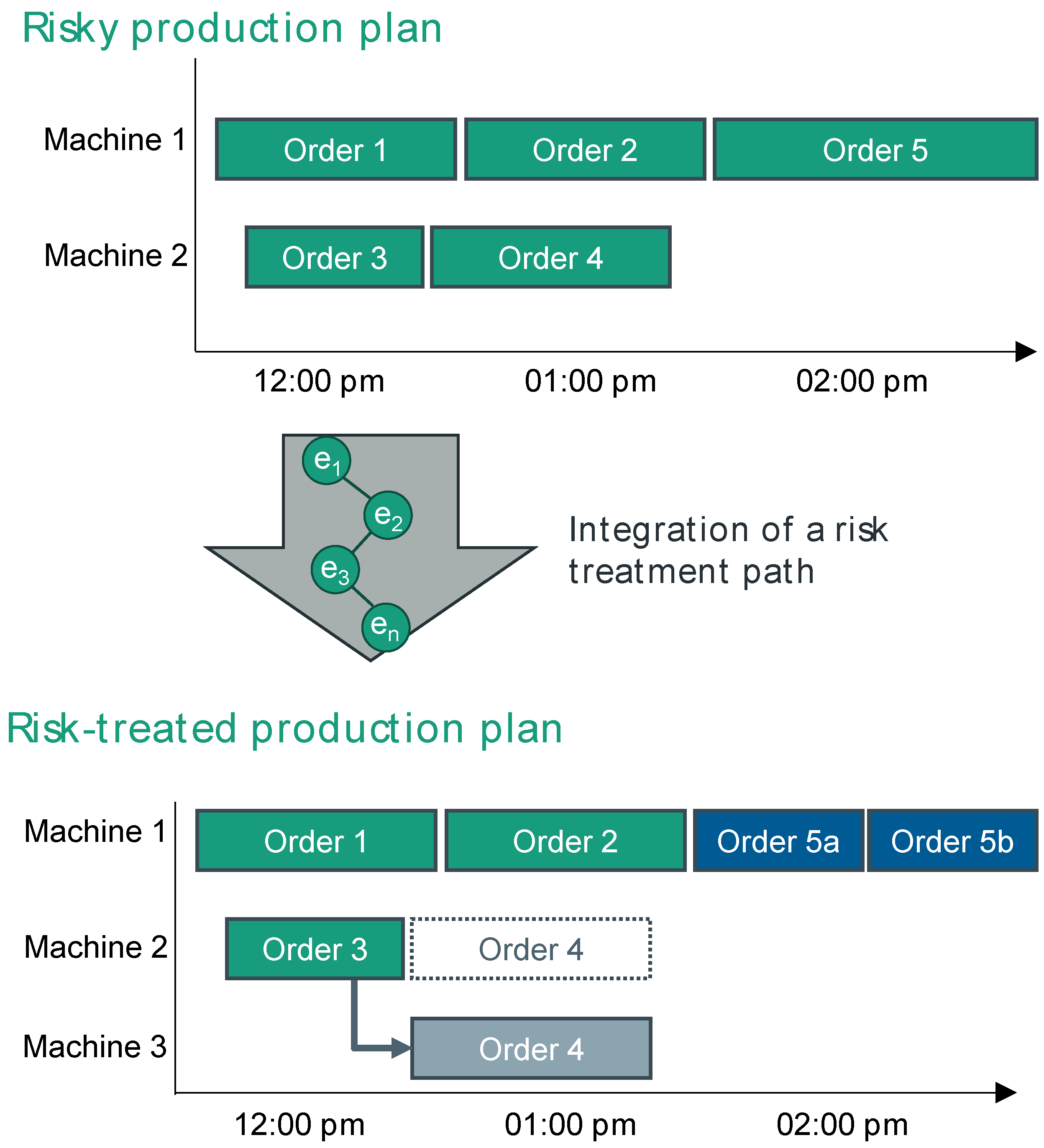
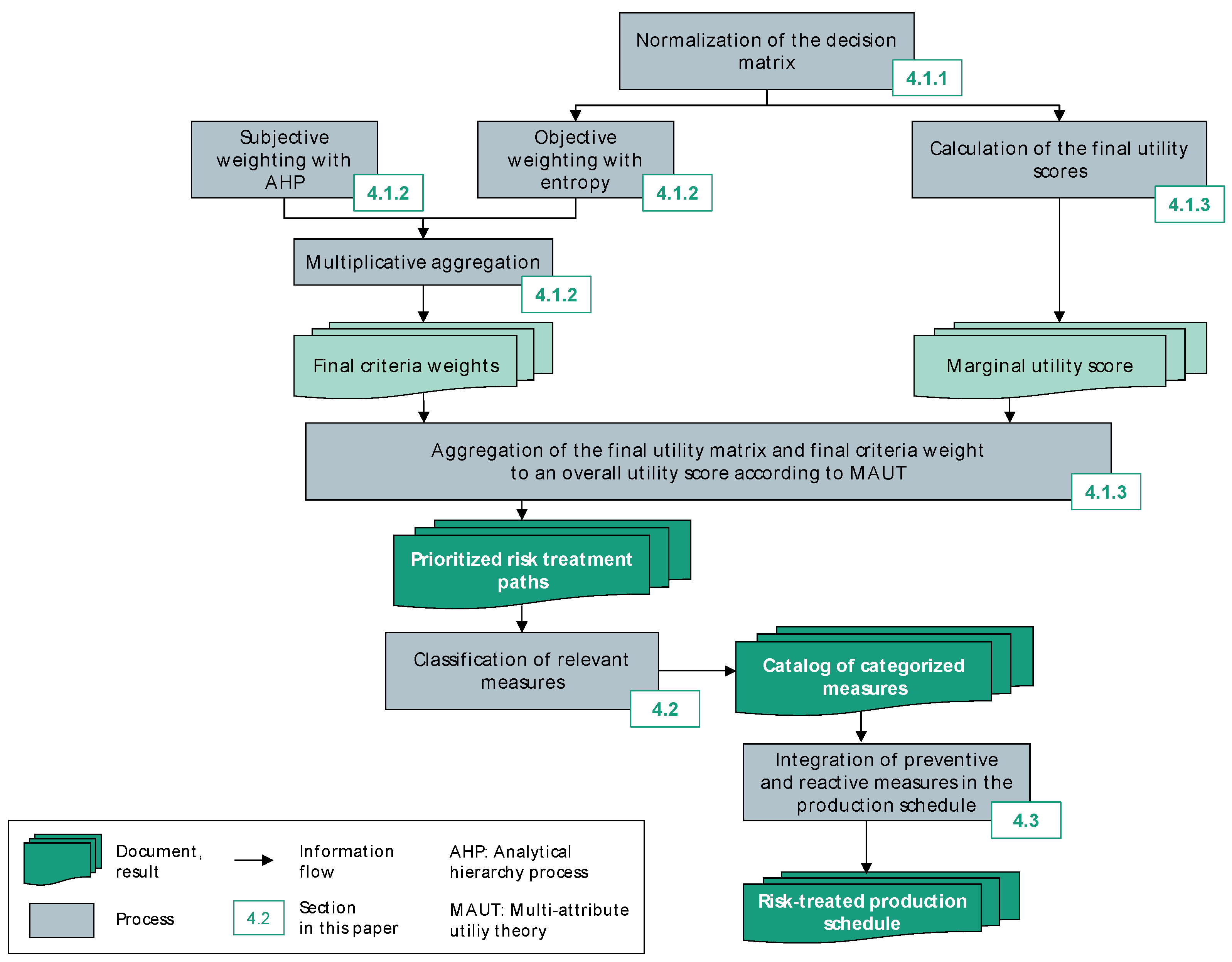



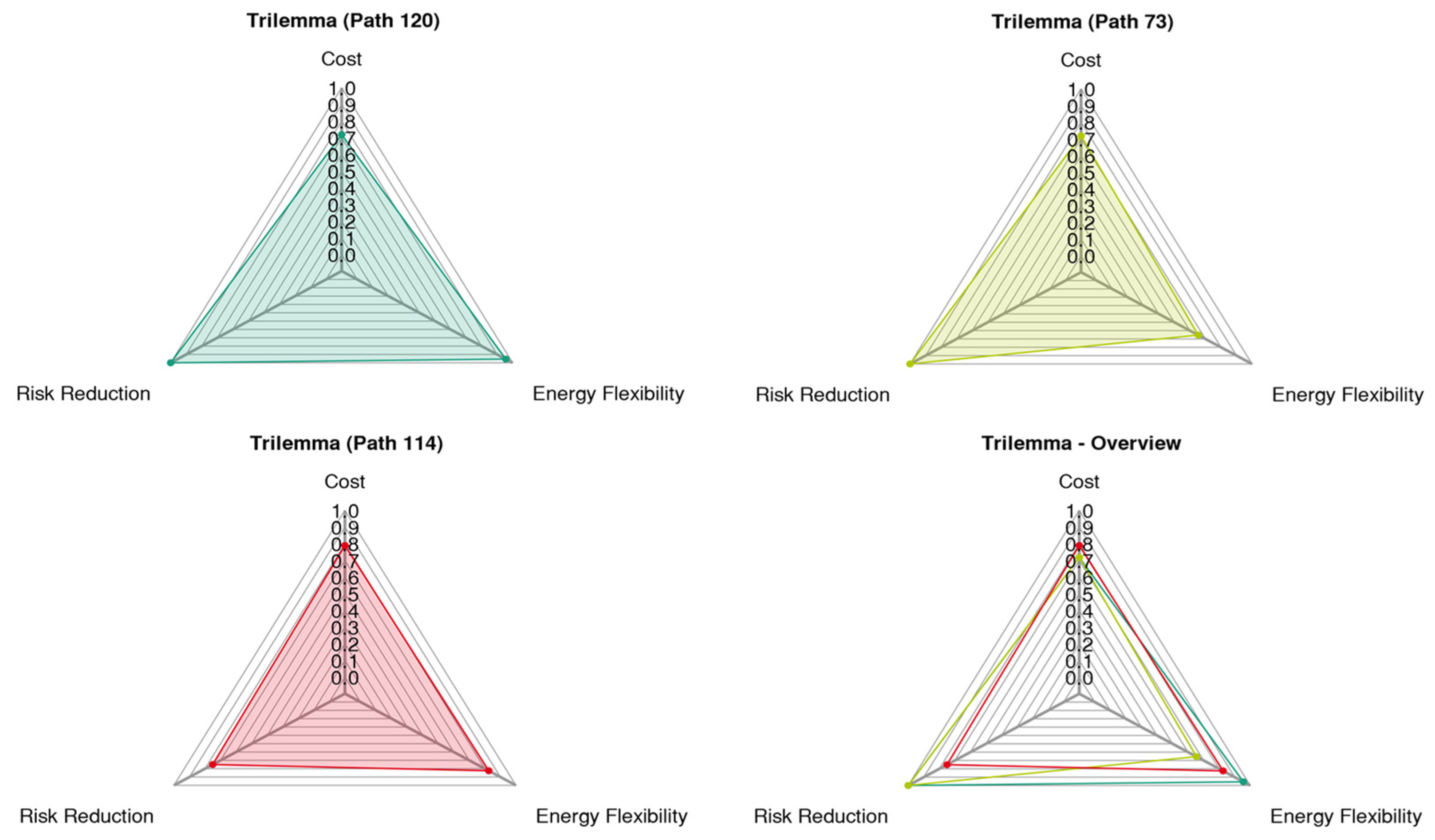
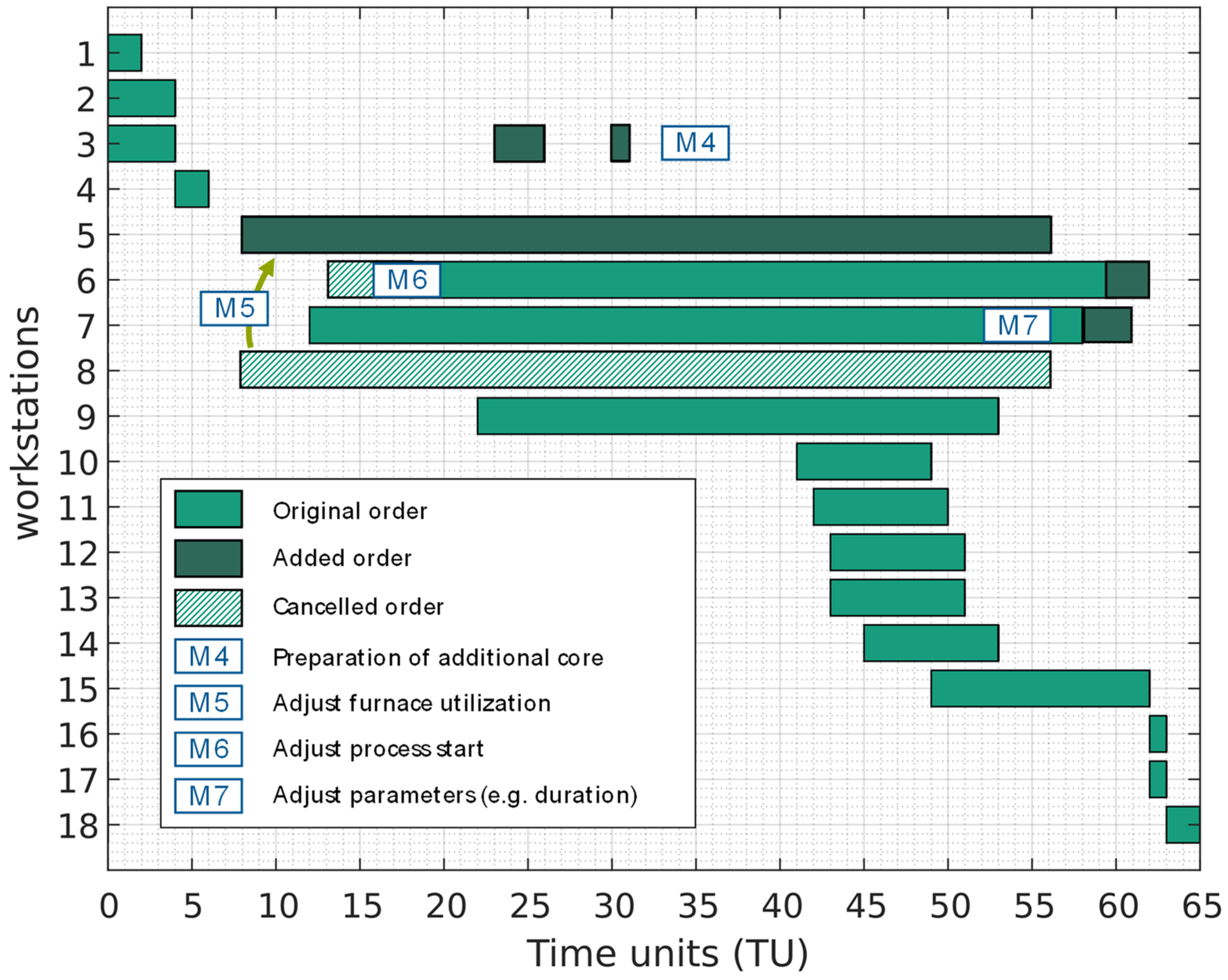
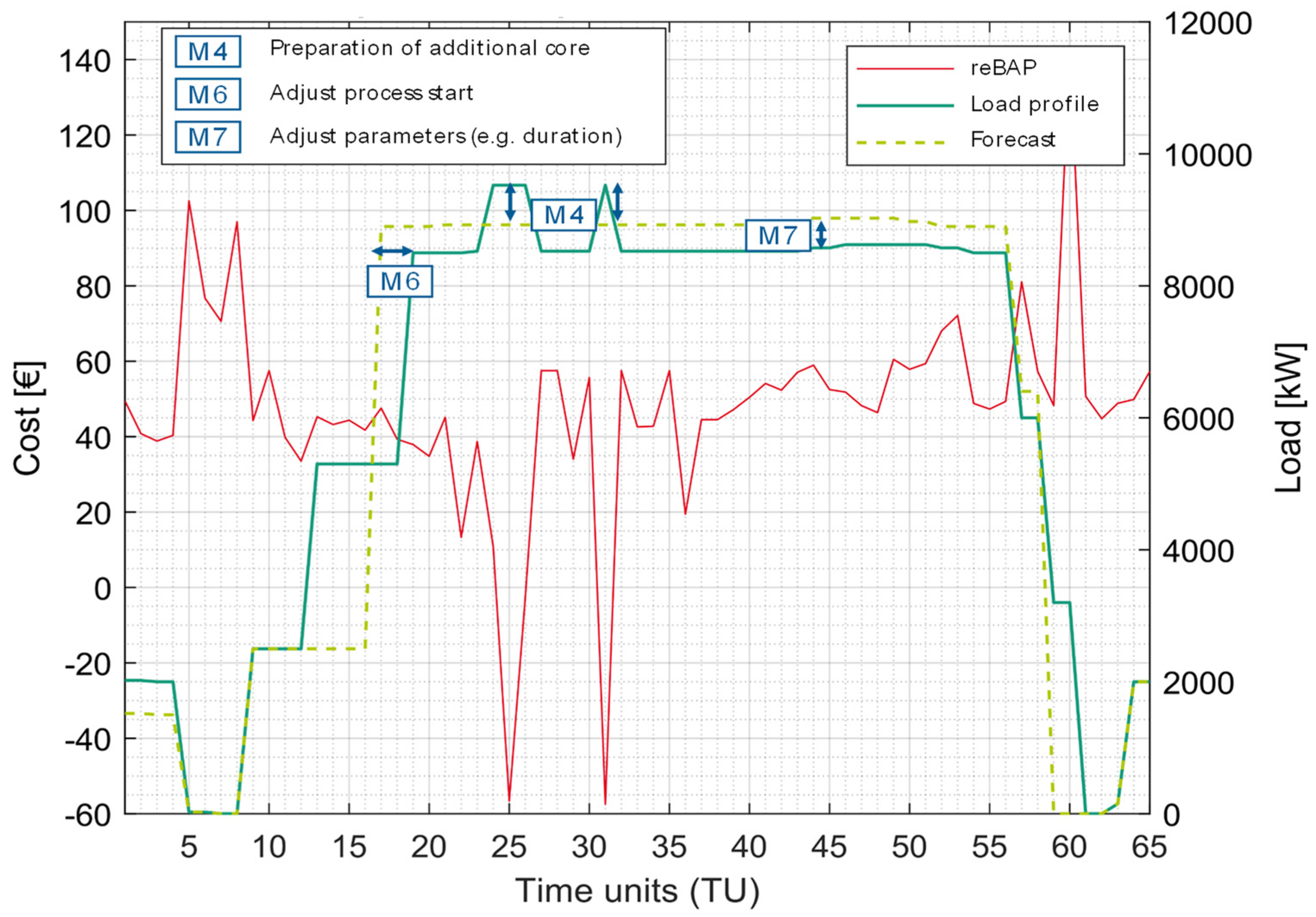
| Parameter | Description |
|---|---|
| Weighting decision matrix | |
| Elements of the weighting decision matrix | |
| Change in measure-induced total costs | |
| Change in risk-induced total costs | |
| Change in total costs | |
| Energy consumption in time unit t | |
| Decision matrix | |
| Duration of job k on station s | |
| Entropy | |
| Energy flexibility | |
| Energy flexibility states | |
| Energy flexibility time | |
| Energy flexibility technologies (e.g., storage facilities) | |
| Due date of job k on station s | |
| Alternative | |
| Criteria | |
| Job | |
| Probability of occurrence of risks and measures | |
| Probability of occurrence of risks | |
| Maximum peak load | |
| Deviation of the actual energy consumption from the forecasted load profile | |
| Power consumption of job k on station s | |
| Planned power consumption in time period t | |
| Quantity deviation cost | |
| Rating for alternative i with criterion j | |
| Station | |
| Start time of job k on station s | |
| Time unit | |
| Marginal utility score for alternative i with criterion j | |
| Final utility score for alternative i | |
| Eigenvector | |
| Weighting | |
| Subjective criteria weighting by analytic hierarchy process (AHP) | |
| Objective criteria weighting by entropy | |
| Final weighting for a criterion j | |
| Largest eigenvalue |
| Intensity of Importance on an Absolute Scale | Definition | Explanation |
|---|---|---|
| 1 | Equal importance | Two activities contribute equally to the objective |
| 3 | Moderate importance of one over another | Experience and judgment slightly favor one activity over another |
| 5 | Essential or strong importance | Experience and judgment strongly favor one activity over another |
| 7 | Very strong importance | An activity is strongly favored and its dominance demonstrated in practice |
| 9 | Extreme importance | The evidence favoring one activity over another is of the highest possible order of affirmation |
| 2, 4, 6, 8 | Intermediate values between the two adjacent judgments | When compromise is needed |
| Reciprocals | If activity i has one of the above numbers assigned to it when compared with activity j, then j has the reciprocal value when compared with i. | |
| ID | Risk (Frequency) | Extent of Damage | ID | Measure |
|---|---|---|---|---|
| R1 | Mold for a small part is faulty—exchange of mold pattern is possible (1 per week) | Time delay to casting and subsequent processes | M1 | Switch to casting panel with identical material requirements |
| Additional post-processing | M2 | Casting with increased post-processing effort | ||
| R2 | Mold for a small part is faulty—exchange of mold pattern is not possible (1 per week) | Additional order to be planned; changed load profile | M3 | Preparation of an additional mold |
| Additional post-processing | M2 | Casting with increased post-processing effort | ||
| R3 | Core for a small part is faulty—exchange of core box is possible (2 per week) | Time delay to casting and subsequent processes | M1 | Switch to casting panel with identical material requirements |
| additional post-processing time | M2 | Casting with increased post-processing effort | ||
| R4 | Core for a small part is faulty—exchange of core box is not possible (2 per week) | Additional order to be planned; changed load profile | M4 | Preparation of an additional core |
| Additional post-processing | M2 | Casting with increased post-processing effort | ||
| R5/R6/R7 * | Furnace failure (2 per year) | Delay melting | M5 | Adjust furnace utilization if an unoccupied furnace is available |
| Delay melting | M6 | Adjust process start | ||
| Delay melting; changed load profile | M7 | Adjust parameter melting temperature and duration | ||
| M8 | Interrupt melting process (only possible for small TUs) | |||
| R6 | Forklift failure (5 per week) | Time delay in follow-up processes | M9 | Provision of a spare forklift |
| M10 | Switching to transport trolleys |
| Cost | Energy Flexibility | Risk Reduction | Final Weighting | |
|---|---|---|---|---|
| Cost | 1 | 1/9 | 1/3 | 0.0679 |
| Energy flexibility | 9 | 1 | 6 | 0.7703 |
| Risk reduction | 3 | 1/6 | 1 | 0.1618 |
| Marginal Utility Score | Final Utility Score | |||
|---|---|---|---|---|
| Criteria | Cost | Energy Flexibility | Risk Reduction | |
| Weight | 0.0082 | 0.2700 | 0.7218 | |
| No. 120 | 0.3930 | 0.8689 | 1.0000 | 0.9596 |
| No. 73 | 0.3930 | 0.3107 | 1.0000 | 0.8089 |
| No. 114 | 0.5028 | 0.5677 | 0.7507 | 0.6992 |
| ID | Description | Type | Effect on the Process |
|---|---|---|---|
| M4 | Preparation of an additional core | Reactive | Altering |
| M5 | Adjusting furnace utilization if an unoccupied furnace is available | Reactive | Supplementing |
| M6 | Adjust process start furnace | Preventive | Supplementing |
| M7 | Adjust parameter melting temperature and duration of furnace | Preventive | Supplementing |
Publisher’s Note: MDPI stays neutral with regard to jurisdictional claims in published maps and institutional affiliations. |
© 2022 by the authors. Licensee MDPI, Basel, Switzerland. This article is an open access article distributed under the terms and conditions of the Creative Commons Attribution (CC BY) license (https://creativecommons.org/licenses/by/4.0/).
Share and Cite
Roth, S.; Huber, M.; Schilp, J.; Reinhart, G. Risk Treatment for Energy-Oriented Production Plans through the Selection, Classification, and Integration of Suitable Measures. Appl. Sci. 2022, 12, 6410. https://doi.org/10.3390/app12136410
Roth S, Huber M, Schilp J, Reinhart G. Risk Treatment for Energy-Oriented Production Plans through the Selection, Classification, and Integration of Suitable Measures. Applied Sciences. 2022; 12(13):6410. https://doi.org/10.3390/app12136410
Chicago/Turabian StyleRoth, Stefan, Mirjam Huber, Johannes Schilp, and Gunther Reinhart. 2022. "Risk Treatment for Energy-Oriented Production Plans through the Selection, Classification, and Integration of Suitable Measures" Applied Sciences 12, no. 13: 6410. https://doi.org/10.3390/app12136410
APA StyleRoth, S., Huber, M., Schilp, J., & Reinhart, G. (2022). Risk Treatment for Energy-Oriented Production Plans through the Selection, Classification, and Integration of Suitable Measures. Applied Sciences, 12(13), 6410. https://doi.org/10.3390/app12136410






